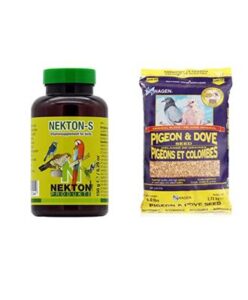If you are considering building a pigeon coop, there are a few things you should keep in mind to create a safe and comfortable home for your birds. In this article, we will cover the essential steps to build a pigeon coop, including selecting the right location, materials needed, and important factors to keep your pigeons healthy.
Whether you are a racing pigeon enthusiast, homing pigeon keeper, or simply enjoying the beauty of these birds, this guide will help you build a pigeon coop that will meet the needs of your feathered friends.
To Build A Pigeon Coop, follow these steps:
- Measure Up.
- Materials.
- Frame and Floor.
- Walls and Screens.
- Install The Roof.
- Attach The Wire Screens.
- Fit Roosting and Nesting Spots.
- The Door.
- Keeping the Coop Safe.

Step By Step Process of Building a Pigeon Coop
Building a pigeon coop may sound daunting but a simple design with basic materials can be assembled by anyone with reasonable DIY skills. This guide will provide you with a step-by-step process for building a pigeon coop that is comfortable and safe for your birds.
1. Measure Up:
Before starting, measure the area where the coop will be built and draw it to scale on graph paper. This step will allow you to visualize the space and determine the precise amount of materials required for the project.
2. Materials:
The materials required for this project are plywood, PVC pipes, chicken wire, sheet metal, 2x4s and 4x4s for the frame and legs, screws, and nails. PVC pipes are great for setting up dummy eggs, and efficient guidance tools for the pigeons.
3. Frame and Floor:
To start building the coop, dig four holes for the corner posts and fix a 2×4 to the front of the 4×4 at each mark. Another 2×4 should be fixed six feet up from the bottom. The frame for the floor is created by nailing 2×4 boards with measured-cut plywood sheets screwed or nailed in place. This provides a secure platform for the coop and your pigeons.
4. Walls and Screens:
Create support by nailing or screwing a 2×4 on each 4×4 corner board and then attaching another 2×4 every 12 inches around the coop. Fix plywood to the support and 4×4 corners by cutting it to fit, making sure it is not taller than the shortest 4x4s forming the corners. Install a door on the front and a window measuring a square foot on both sides. Attach a wire screen to each window for ventilation. Cover the rest of the coop with sheet metal with an opening for the window and door.
5. Install The Roof:
Nail/screw four 2x4s together to create a frame slightly larger than the coop. Fasten plywood to cover the frame. If you intend to weatherproof your coop with sheet metal, attach it to the roof piece now, then set it aside.
6. Attach The Wire Screens:
Attach the wire screen to the triangular gaps that appear on both sides of the coop. Create window panes with cut sheets of Plexiglas that can be opened and closed as desired. This allows air circulation while keeping the birds safe from pests.
7. Fit Roosting and Nesting Spots:
To provide a resting and nesting space for your birds, use 2x4s to create shelves in the coop and add strips of plywood for nesting areas with a depth less than the coop. This gives your birds their own space to rest and lay eggs.
8. The Door:
Screw the hinges into place, making a hole in the door panel before hammering a nail in a suitable place, and threading some rope through the hole in the door. This can then be tied to the nail to keep the door open when required.
9. Keeping the Coop Safe:
To keep your pigeons healthy and safe, provide them with fresh water, and a mixture of grains twice a day. Clean the coop periodically by removing any debris, and checking for dislodged nails, breakages, and anything that could injure a bird. A wooden floor is great to keep the birds comfortable and protect their feet.
Building a pigeon coop may seem challenging, but with the right materials and steps, you can create a comfortable and safe home for your pigeons.
The Scoop on Pigeon Poop:
When it comes to pigeon coops, cleanliness is key. Proper sanitation practices not only keep the birds healthy but also enhance living conditions. Manure management, in particular, is an important aspect of pigeon coop design. With regular cleaning and disposal of manure, you can create a healthier environment for your birds with less odor.
Pigeon excrement is not just waste but can be an excellent source of fertilizer. With a bit of collection and processing, you can turn pigeon poop into an ideal food supplement for your plants and garden. It’s high in several essential nutrients and can significantly improve harvest yields.
The ideal food for pigeons is a mixture of grains. You can source these from local feed stores or online. Alongside grains, pigeons also require clean, fresh water to ensure proper hydration and overall health. Ensure the water dish is kept filled and washed daily to avoid contamination.
When it comes to pigeon coop designs, ensure you provide adequate space for your birds. Aim for at least 300 cubic feet, which allows sufficient air circulation. Additionally, nesting boxes are essential for pigeons to lay their eggs and keep their young, so allow for one nest box for every breeding pair. Make sure the nesting boxes are comfortable and clean, which can improve your birds’ health and breeding success.
Pigeon Loft Design
When it comes to designing a pigeon loft, there are several factors you should consider. Choosing the right location is key; make sure the area is free from drafts and predators. Ideally, your pigeon loft should be placed in an area that receives direct sunlight throughout the day.
1. Pigeon Loft Design: Key Components and Fixtures for Homing Pigeons:
When it comes to setting up and maintaining a pigeon loft, creating a dry and well-ventilated enclosure is highly crucial. The size of the loft and the fixtures are essential components that should be included to ensure the wellness, safety, and comfort of your homing pigeons.
2. Key Components:
The loft should have a minimum of four walls, a floor, and a roof. The roof should be sloped towards the back to prevent water from collecting around the landing board.
A well-made loft must have external fixtures such as ventilators, turbines, traps, and aviaries. These fixtures will prevent vermin, including aerial predators, and encourage plenty of fresh air and sunshine for the birds.
The size of the enclosure should be large enough to allow at least 8 to 10 cubic feet of airspace per bird. The loft needs to have three partitions designated for breeders, young birds, and old birds. It’s important to ensure the ceiling height is sufficient to allow for easy cleaning and maintenance.
3. Fixtures:
Traps are a must-have fixture in pigeon lofts. The trap allows the birds to fly outside the loft and come back in but not fly out again. The landing board should be large enough for all the birds to land simultaneously, and the trap should be in its center to avoid accidents. Simple traps can be made out of wire coat hangers or purchased for around $20.
Aviaries are excellent fixtures that encourage birds to have constant access to fresh air and sunshine. Install a small aviary in each section of the loft, allowing the birds to go out into the sun and rain, and close them off to keep weather elements outside the loft.
Perches throughout the loft and aviary are crucial to supporting the birds’ sociability and reducing quarreling. Construct perches out of one-by-four-inch boards or half-inch doweling. Tree branches also work but are challenging to clean.
4. Air Circulation:
Air circulation is fundamental to a pigeon’s well-being, and proper ventilation in the loft is necessary to maintain a healthy environment for the birds. Fans and electricity can be installed to enhance air movement and encourage convenience. Many fanciers keep their pigeons on grated floors or deep litter, which is preferred to maintain healthy space and dryness.
FAQs
A pigeon coop should be at least 8 square feet for every pair of birds.
You will need plywood, PVC pipes, chicken wire, sheet metal, 2x4s, and 4x4s for the frame and legs, screws, and nails.
It is recommended to clean the coop at least once a week to keep it sanitary and free from debris.
Make sure that your pigeons have access to fresh water and a mixture of grains twice a day.
Ideally, use durable and weather-resistant materials like wood or metal for the frame and walls. Consider using wire mesh for proper ventilation and security. Ensure the materials are non-toxic and easy to clean.
Pigeons require sufficient space to move around comfortably. A standard recommendation is about 2 square feet of floor space per bird. Ensure there’s enough room for perches, nesting boxes, feeding, and drinking areas.
Yes, proper ventilation is crucial for the health of the pigeons. Good airflow helps regulate temperature, reduces moisture buildup, and prevents respiratory issues. Consider adding vents, windows, or adjustable openings for adequate airflow.
Provide perches for roosting and resting, nesting boxes for breeding pairs or laying eggs, food and water containers that are easily accessible, and proper lighting for the pigeons’ well-being.
Ensure the coop is secure by using sturdy wire mesh with small openings to prevent entry by predators like rats, raccoons, and birds of prey. Check for any gaps or holes and reinforce them. Locks or latches on doors also add an extra layer of security.
Check with your local authorities or zoning department regarding any regulations or permits needed for keeping pigeons or constructing a coop. Some areas might have specific guidelines regarding the size, location, or number of pigeons allowed in residential areas.
Conclusion
The information and resources provided in this article can be immensely helpful for those interested in building a pigeon coop. From understanding the different breeds of pigeons and their care considerations to finding resources and communities to connect with other pigeon fanciers, this article covers a range of important topics.
With the right knowledge, materials, and attention to detail, building a comfortable and safe pigeon coop can be a rewarding and fulfilling experience for bird lovers and breeders alike.
So, use these tips and resources to create a home for your pigeons that meets their needs and protects them from predators, while also providing ample space for them to exercise and fly.


